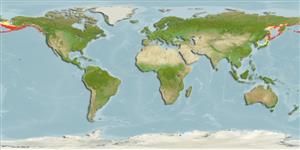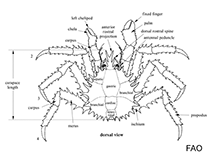Malacostraca |
Decapoda |
Lithodidae | Lithodinae
Environment: milieu / climate zone / depth range / distribution range
Ecology
Benthic; depth range 0 - 461 m (Ref. 865). Temperate; -1°C - 18°C (Ref. 121574), preferred 5°C (Ref. 107945); 65°N - 36°N, 127°E - 126°W (Ref. 78813)
Northern Pacific and the Arctic: from South Korea to Kamchatka Krai, Russia, and Norton Sound, Alaska to Great Bay, Vancouver Island. Introduced in Arctic Russia and Norway in the Barents Sea between water temperatures between 1.0 °C and 13.5 °C (Ref. 121575). Temperate to polar.
Length at first maturity / Size / Weight / Age
Maturity: Lm 10.7, range 7 - 11.28 cm Max length : 22.0 cm CL male/unsexed; (Ref. 78813)
Has two migrations, mating-molting and feeding migration (Ref. 78813). This is the most valuable commercial crab on the Pacific coast of North America (Ref. 865). Maximum depth from Ref. 121573. This is a benthic species. The crab is confined mainly to sand-and-pebble bottom. It prefers areas of hard bottom and thickets of macrophytes (Ref. 121573). At summer time, adult and juvenile distribute in mostly shallow shelf less 100 m. Non-migratory juveniles stay in one area throughout the year. Adults overwinter at depths of 150-300 m. Their cyclic migrations are from shallow waters to deep waters and vice versa. At each season they choose the most favorable feeding conditions, shelters for molting and suitable hydrological conditions for life. At spring, adults migrate from depths to shallow waters of 2 to 9 m for spawning: larvae hatching from mature external eggs, females molting in the presence of males and then mating (Ref. 121574). The molting process lasts 4-10 minutes. Curing of the shell lasts about 2-3 days, during which two missing layers of the shell are formed. Contamination degree of the shell allows to determine whether the crab has molted in the present or last year. Particularly, the ventral view of the shell is contaminated and erased intensely (Refs. 121580, 121581). After spawning or molting, the crabs spend the remainder of summer and whole autumn to feed. Usually the crabs move zigzag between forage places at an average speed of 1.4-2.3 km per day (Refs. 121582, 121583). Feeding migrations are dependent on two factors: distribution of forage places and the water temperature (Ref. 121584). Both an opportunistic and a generalist predator. A number of studies revealed that,, when introduced to new virgin areas, the species prefers preying on large specimens of benthic animal groups such as bivalves, echinoderms, and sipunculids (Ref. 113901). Adults mainly feed on mollusks, crustaceans and polychaetes. In addition, its regular prey are echinoderms, sponges, rhizopods, bryozoans and algae. The average daily diet of adult over 150 mm in size is 0.8% of its body weight. No differences in food preference were found between male and female crabs. Juveniles feed on ophiuroids, sponges, bivalves, as well as polychaetes and barnacles. The diet of juveniles with a carapace width of 2-20 mm is poorer than that of an adult's, and it is characterized by a large abundance of sponges and hydroids (Ref. 121579). These crabs exhibit cannibalism (Ref. 101157).
Life cycle and mating behavior
Maturity | Reproduction | Spawning | Eggs | Fecundity | Larvae
At spring adult crabs concentrate in shallow water for larvae hatching, molting, and then pairing and laying new eggs on pleopods. Larvae hatching from eggs (protozoa and zoea) live in the pelagic zone, as a rule, for more than two months. During this time the larvae manage to molt four times and turn into a glaucothoe, which develops all legs already, claws, shell of cephalothorax is covered with thorns. Glaucothoe passes to bottom existence. After a month glaucothoe molts and turns into juvenile of red king crab. Three years later juvenile leave the thicket of algae and move to sandy seabed. Crabs found in any pod are 24 and 69 mm in CL. Crabs begin to gather in pods and make extended migrations (Ref. 121585). Complete larval development requires an average of 460 degree days (Ref. 121587). The optimum temperature for the development of zoea is about 3 °C, the development of the late stages occurs at about 8 °C (Ref. 121588).
Jørgensen, L.L. 2006 NOBANIS-Invasive Alien Species Fact Sheet- Paralithodes camtschaticus. Online Database of the North European and Baltic Network on Invasive Alien Species-NOBANIS www.nobanis.org[Date assessed 09/26/08]. (Ref. 78813)
IUCN Red List Status
(Ref. 130435: Version 2025-1)
CITES status (Ref. 108899)
Not Evaluated
Not Evaluated
Threat to humans
Human uses
Fisheries: commercial
FAO - Fisheries: landings | FishSource | Sea Around Us
Tools
More information
PhysiologyOxygen consumption
Human RelatedStamps, coins, misc.
Internet sources
Estimates based on models
Preferred temperature
(Ref.
115969): 0.5 - 6.8, mean 3 (based on 387 cells).
Resilience
Medium, minimum population doubling time 1.4 - 4.4 years (K=0.25; tm=7; Fec=200,000).
Fishing Vulnerability
Moderate to high vulnerability (51 of 100).
Climate Vulnerability
Moderate vulnerability (39 of 100).
Nutrients : Calcium = 109 [35, 184] mg/100g; Iron = 1.59 [1.21, 1.97] mg/100g; Protein = 20.2 [19.2, 21.3] %; Omega3 = 0.285 [0.185, 0.386] g/100g; Selenium = 48.3 [-31.7, 128.3] μg/100g; VitaminA = 0 μg/100g; Zinc = 1.79 [1.17, 2.40] mg/100g (wet weight); based on
nutrient studies.




